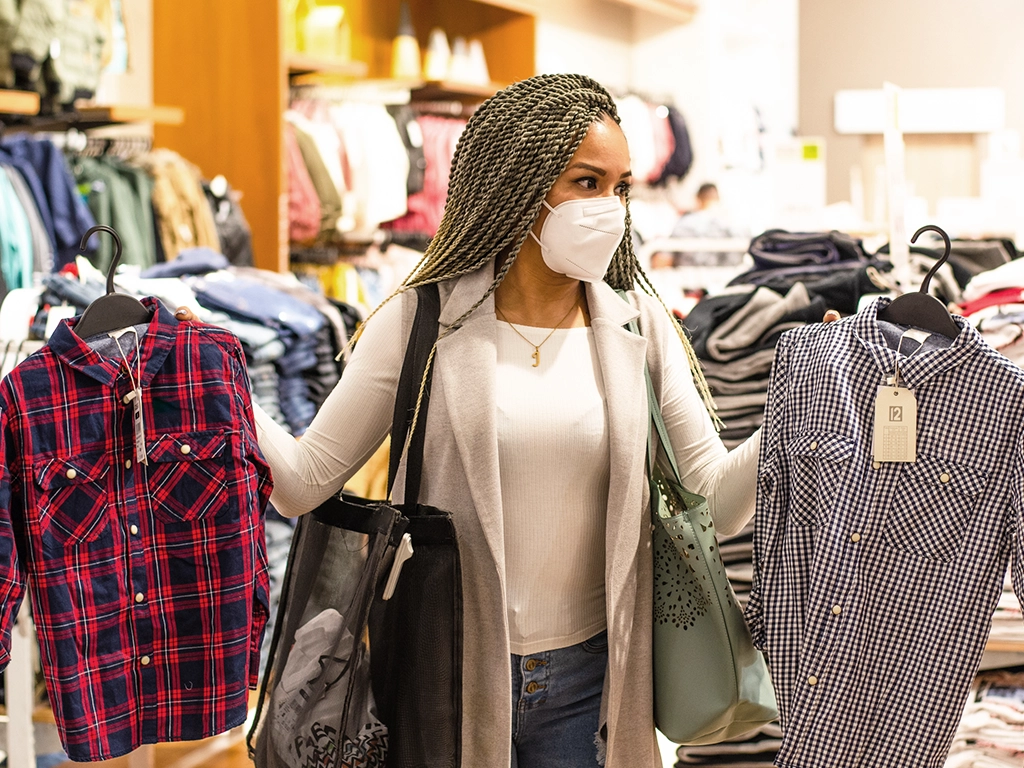Last year, we answered 20 of your most pressing questions about flu season. However, COVID-19 changes everything—even our understanding of the flu. Thus, we've updated 5 of our answers from last year with the latest data—all part of our mission to ensure your organization stays as sniffle-and-fever-free as possible this winter.
Q. How is the flu spread?
A: Unfortunately, the CDC's current model of how the flu spreads has become outdated.
According to the CDC:
Most experts think that flu viruses spread mainly by droplets made when people with [the] flu cough, sneeze, or talk. These droplets can land in the mouths or noses of people who are nearby (usually within about 6 feet away) or possibly be inhaled into the lungs. Less often, a person might get [the] flu by touching a surface or object that has flu virus on it and then touching their own mouth, nose, or possibly their eyes.
However, this model is not the only means (and perhaps not even the primary means) of influenza transmission. Studies conducted before and during the COVID-19 pandemic have emphasized that exhaled particles from infected people can be smaller, travel farther, and stay in the air for much longer than we previously realized. Such particles are not called droplets, but aerosols. Wired gives a solid example of this when they describe the findings of indoor air researcher Yuguo Li:
Li's elegant simulations showed that when a person coughed or sneezed, the heavy droplets were too few and the targets—an open mouth, nostrils, eyes—too small to account for much infection. Li's team had concluded, therefore, that the public health establishment had it backward and that most colds, flu, and other respiratory illnesses must spread through aerosols instead.
Note that just because aerosols are a source of infection doesn't mean that distance doesn't matter. Close, unmasked contact is certainly riskier than working across the room. What these findings do mean is that the problem is the indoor space itself, not just the immediate area around a sick person. Thus, organizations need to focus on improving indoor air this flu season.
Q. When is flu season?
A: According to the CDC, the influenza virus circulates year-round, but cases increase in temperate zones between mid-fall and mid-spring. In the United States, this means the flu season lasts from October to April or May, while in the southern hemisphere it lasts from April to September. (Tropical and subtropical climates are outside the scope of this article.) Colds also increase during this time, so the period is sometimes referred to as ‘cold & flu season’.
Either because of anti-COVID measures or because it was out-competed by COVID-19, both the 2020-2021 and 2021-2022 flu seasons were mild. However, a particularly bad flu season in Australia has experts fearing that we will not get another reprieve this year. As a macabre bonus, a COVID wave is expected around the same time. Popular culture has nicknamed such a theoretical conflux of influenza and COVID the ‘twindemic.’ This twindemic is expected to put a large strain on the healthcare system, and, by extension, the labor force available to companies and organizations this winter.
 Flu season occurs at the same time as the holiday shopping season. Managers must take precautions to minimize the flu's effect on their business. (Image credit: Getty / Juan Jose Napuri)
Flu season occurs at the same time as the holiday shopping season. Managers must take precautions to minimize the flu's effect on their business. (Image credit: Getty / Juan Jose Napuri)
Q. How is the flu different from COVID-19?
A: The most obvious difference is that the flu is caused by the influenza virus, while COVID-19 is caused by the SARS-CoV-2 virus.
However, there are very few other easily distinguishable differences. Per the Mayo Clinic, both the flu and COVID cause similar symptoms, such as:
- Fever
- Cough
- Shortness of breath or difficulty breathing
- Tiredness
- Sore throat
- Runny or stuffy nose
- Muscle aches
- Headache
In rare cases, they may even cause nausea, vomiting, and diarrhea, though these symptoms are more common in children.
The flu and COVID's incubation periods are even similar. Flu symptoms can appear 1 to 4 days after exposure, while COVID symptoms can appear 2 to 14 days after exposure. For these reasons, the best way to distinguish between the flu and COVID-19 is a PCR test. There are, however, a few notable differences:
- Loss of taste or smell: Official guidance still states that the flu rarely causes a loss of taste or smell, while such is a common symptom of COVID-19. However, a very recent study by Zoe Health found that this symptom is becoming much less common during COVID-19 infections as well.
- Mortality rate: The overall mortality rate for the COVID-19 pandemic in the United States is 1.1% across all age groups for all 3 years of the pandemic. The average mortality rate for the flu from late 2010 to early 2020 was 0.12%. Even though the mortality rate of COVID-19 is dropping, it's still more deadly than the flu.
- Effect on young people: While COVID-19 remains deadly for age groups, children who get COVID-19 are more likely to be asymptomatic or have mild symptoms. The flu, by contrast, comes on them suddenly, bringing very noticeable symptoms.
- Secondary complications: Both COVID-19 and the flu can lead to severe complications, including pneumonia, respiratory failure, and multiple organ failure. However, the flu is more likely to cause a secondary bacterial infection. In contrast, COVID-19 can cause blood clots and multisystem inflammatory syndrome.
- Recovery time: Healthy adults usually recover from the flu in 7 to 10 days. Meanwhile, COVID-19 recovery usually takes at least 10 days. Of course, COVID-19 is also known for its infamous long COVID symptoms, which can last for years.
 Flu season can affect employee productivity. (Image credit: Getty / ER_Creative)
Flu season can affect employee productivity. (Image credit: Getty / ER_Creative)
Q: How does the flu impact businesses and the economy?
A: As of 2015, the CDC estimated that sick days cost U.S. employers $225.8 billion annually in the United States. The Integrated Benefits Institute estimates that “illness-related lost productivity” cost US employers $575 billion in 2019. While it's not clear what percentage of this is due to the flu, flu season undoubtedly does its best to impair your company's bottom line.
Admittedly, the effect of the flu on employers is not as well-studied as one could hope; nevertheless, its effect on employees is clear. As we reported last year, a study by the National Center for Immunization and Respiratory Diseases found that the flu cost U.S. employees more than $10.4 billion in lost wages in 2003 (or $16.78 billion adjusted for inflation) and cost the economy as a whole $87.1 billion (or $140.5 billion adjusted for inflation). This doesn't include the more than 600,000 lost life years and 3.1 million days hospitalized.
Q: Do air purifiers help prevent the flu?
A: Since the flu spreads through indoor air and costs organizations money, it's in an organization's best interest to improve indoor air. One cost-effective way to do so is air purification. But which purifier should you use against the influenza virus?
When the influenza virus is traveling inside droplets or particles of the right size, HEPA filters can remove them from the air. However, this presumes that the particles pass through the filter before a healthy person breathes them in—something which is not guaranteed. Thus, we need a type of purifier that works out in the air of the room itself—also known as active purification.
One form of active purification mimics a process that occurs in outdoor air. Outdoor air contains molecules formed by sunlight and water vapor which break down bacteria, viruses, and fungi. Air purifiers with ActivePure Technology create these same molecules indoors, distributing them throughout the room. Though not a replacement for other flu season precautions, ActivePure has proven effective at neutralizing more than 99.99% of enveloped viral particles in the air and at drastically reducing them on surfaces. ActivePure protects thousands of spaces across the globe, including concert halls, offices, government buildings, and schools.
We assert that active air purification is one of the best ways to invest in your employees this flu season. Contact our air quality experts today to get started.



